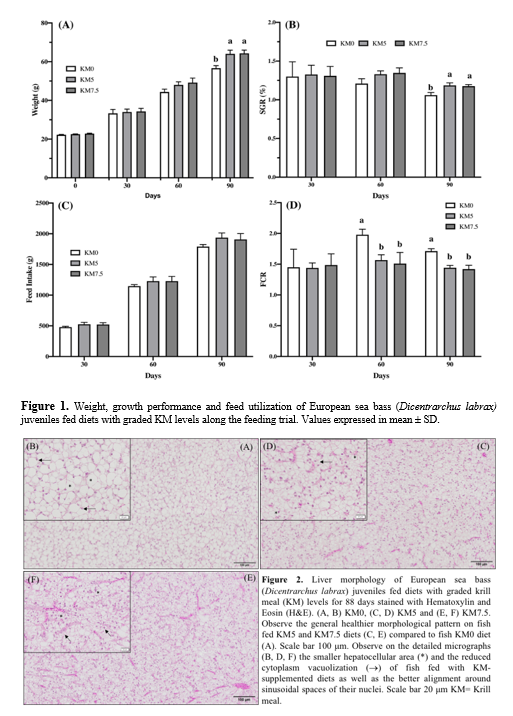REPLACEMENT OF FISH MEAL BY ANTARCTIC KRILL MEAL IN DIETS FOR EUROPEAN SEA BASS Dicentrarchus labrax: GROWTH PERFORMANCE, FEED UTILIZATION AND LIVER LIPID METABOLISM
Introduction
Fish meal (FM) can be partially replaced in the diets of many fish species, but in most cases, high or complete replacements have detrimental effects on fish performance and health. This side effects are mainly due to imbalanced amino acid s and micronutrients, the presence of antinutritional factors or to a direct reduction of feed intake because of decreased diet palatability as the level of alternative protein sources increases. To the date, there is no information on the effect of dietary krill meal (KM) on European sea bass performance and liver lipid metabolism, being the main objective of the present study.
Materials and methods
Three isoproteic and isolipidic experimental diets were formulated containing different KM levels: 0% (control group), 5% and 7.5% KM (QrillTM Aqua; Aker BioMarine Antarctic AS, Norway). European sea bass juveniles were randomly distributed in 12 indoor 500 L fiberglass tanks (3 tanks/diet) at an initial stocking density of 1.5 kg·m-3 . Fish average initial weight and length were 22.54±0.30 g and 11.4±0.1 cm (mean ± SD) and were manually fed until apparent satiation for 90 days (3 times a day, 6 days a week). At the end of the feeding trial , growth performance parameters and food conversion ratio were calculated. Livers, dorsal muscle and whole-body samples from 5 fish per tank were sampled for chemical composition, fatty acid and lipid classes analyses. Livers of 3 fish per tank were collected for morphological and gene expression analyses.
Results
After 90 days of feeding, fish fed KM5 and KM7.5 diets presented higher final weight and improved SGR than fish fed control diet (p<0.05) (Fig. 1). FCR was improved from 60 days of feeding onwards when diets were supplemented with KM (Fig. 1) . Whole-body, muscle and liver proximate composition were not affected by the experimental diets. Regarding tissue fatty acid composition, whole-body and muscle seemed to be more affected by diet composition than liver, which only presented an effect of KM on Σ n-6 HUFA, being the highest in those fish fed KM5. Fish fed KM showed a tendency to present lower liver cholesterol levels than fish fed control diet. KM dietary content was positively correlated with the pigmented material content (r= 0.84, p=0.01 ). F ish fed KM diets (Fig. 2B, 2C) presented smaller hepatocytes area with a more regular-shaped morphology around sinusoidal spaces compared to fish fed the control diet (Fig. 2A). This effect was particularly noticeable in fish fed KM7.5, pointing to a dose-dependent effect of KM on these parameters. S ea bass fed KM5 and KM7.5 diets showed decreased mRNA levels of fads2 (p<0.1) and hmgr (p<0.05) . Despite that no significance differences in fabp7 relative expression were detected among sea bass fed the different dietary KM contents, fish fed KM5 and KM7.5 diets expressed slight lower mRNA levels, which were significantly correlated with liver cholesterol. (Pearson (Pearson correlation= 0.99, p=0.04). lpl mRNA levels were linearly correlated with liver lipids (Pearson correlation= 0.99, p=0.03).
Conclusions
The results of the present study showed that dietary KM at 5% and 7.5% as partial replacer for FM promotes European sea bass juvenile’s growth performance, feed and nutrient utilization. Besides, KM modulates liver lipid metabolism and reduces liver hepatocytes vacuolization. Therefore, presenting KM not only as an alternative protein source in practical diets for European sea bass with low FM/FO content, but also as a potential functional ingredient capable of promoting liver health status.
